|
|
|
Augustus Caesar: The First Roman Emperor
First published April 19, 2010
at Hubpages.com
My previous articles set the stage for a look at individual emperors of
the Ancient Roman Empire, and the coins of significance regarding that
emperor.
Augustus Caesar was the first emperor of Rome. Many of the coins
issued in Rome and throughout the Roman Empire during his reign are common,
and easily obtained. I will give a short rundown on young Octavian
becoming Emperor Augustus, and then look at a few coins.
Augustus Caesar (Gaius Octavius Thurinus) was born in Rome on September
23, 63 BC. He was raised in a blessed environment. He received
the best Roman life had to offer, and was well equipped to face the challenge
of dealing with experienced soldiers and statesmen such as Brutus, Cassius,
and, above all others, Marcus Antonius (Mark Antony).
On March 15, 44 BC, Octavian’s adoptive uncle, Julius Caesar, was murdered.
Octavian was 18 years-old, and living in Apollonia (Albania) with the army.
Hearing of his adoptive uncle’s death, he immediately returned to Rome,
where Brutus, Cassius, and their allies were in control.
Along with Mark Antony and Marcus Lepidus, he formed the Second Triumvirate.
This was an uneasy alliance as Mark Antony was a very powerful and aggressive
individual with a very well developed sense of entitlement. He had
served with Julius Caesar as friend and general for many years. Lepidus,
on the other hand, was a malleable individual who had prospered by skillfully
using a mix of cunning and caution. Octavian and Antony went after
the assassins aggressively, and in 42 BC met and defeated Cassius and Brutus
at Philippi in Macedonia.
Following their defeat, Cassius and Brutus committed suicide. (The battle
at Philippi is interesting and well documented. Cassius committed suicide
because of a perceived loss rather than an actual loss.) At this
time, Octavian returned to Rome and Antony went to Egypt and took up with
Cleopatra VII Philopator; the ex-lover of Julius Caesar and mother of Caesar's
only biological son Caesarion.
Antony and Octavian divided up the empire with Octavian taking the west,
Antony the east, and Lepidus being given Africa. Lepidus stood back
and did not take part in the conflict brewing between Octavian and Antony.
At the harbor of Actium on the west coast of Greece, in 31 BC Octavian,
with his closest friend and general, Marcus Aggripa, met Antony and won
a decisive battle.
Following this loss, Antony and Cleopatra fled to Egypt where they eventually
committed suicide. Shortly after their suicides, Octavian ordered
the death of Caesarion.
In 27 BC, Octavian dismantled his armies, and returned power to the Roman
Senate. A hand-picked and timid Roman Senate immediately voted him
Consul, and named him Augustus (The revered one). This was the start
of the Imperial Roman Empire.
Augustus ruled for 40 prosperous and fairly peaceful years. He created
the Praetorian Guard, who were charged with the protection of the Emperor's
person. He bragged that he found Rome brick and left it marble, and
was loved, as all great people are loved, by those who gained from his
efforts.
He suffered some losses. The most noteworthy occurred in 9 AD when
Legion XVII, Legion XVIII, and Legion XIX, under the command of Publius
Quintillius Varus, were slaughtered by Germanic tribes in the Battle of
the Teutoburg Forest. There were 15 to 20 thousand Roman soldiers
killed, and the three legions were never reestablished. Following
this loss, a war continued for seven years establishing the Rhine as Rome’s
northern boarder for the next four hundred years.
Gaius Julius Caesar Octavianus Augustus died on August 19, in the year
14 AD, the first emperor in a line of rulers that ended in the year 1453
AD with the death of Constantine XI.
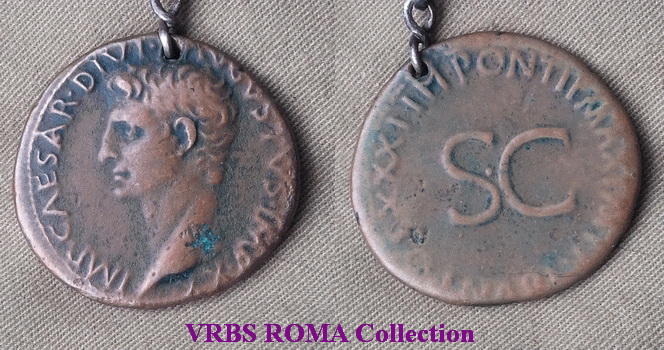
(29/30mm 10.79grms)
AUGUSTUS. 27 BC-14 AD Æ As Rome mint Struck
11-12 AD
Obv. IMP CAESAR DIVI F AVGVSTVS IMP XX, bare head
of Augustus left
Rev: PONTIF MAXIM TRIBVN POT XXXIIII around SC
RIC 471; Sear 1689
This coins is the size of a US half dollar. I got if for $110 US
because it has a hole just above the emperor’s head. I bid on it
because of that hole. I thought it might go for a price I could afford,
and I fantisized as to how many people before me might have worn this same
coin near their beating hearts.
When it arrived, I carefully placed a sterling silver wire bail through
the hole, and hung it on a silver chain. I wore it for a while, but
stopped when I saw high spots showing polish due to the polishing effect
of my half Sicilian, and half Irish/English hairy chest. However,
my guilt over this microscopic deterioration was obscured by the pleasure
of imaging about how many necks it might have hung from. Thoughts
of what that coin had been near during its 2,000 years. While I wore
it, it hung near shoes being tied, hands being washed, meals eaten, books
read, bodies embraced and hovered over, sun shine, and moon glow.
I wore it for less than two years; imagine a thousand time that.
Two thousand years as an ornament might not be probable, but it is possible.
It was pleasant to ponder.
I have wondered at what point in history the hole was placed in the coin.
I have seen three of this variety of coin with holes just above the emperor’s
head. Bronze coins had not been made for nearly a hundred years before
Augustus reformed Roman coins and began issuing base metal coins again.
This is a bronze coin minted during 10 to 12 AD. Could it have been
a social ritual to wear this coin on a string or chain? It was issued
only two to four years before Augustus died. Was it worn to remember
Augustus? Could wearing it have had meaning something like we use
the crossed ribbon to remind us of the unfortunate among us, the mistreated,
and lost. Maybe it’s like wearing red on Friday to think of, and
remember the troops. Whatever the real story is, the fantasies are
pleasant, and my coin, wore smooth over most of its surface, was most likely
old and smooth when the hole was drilled.
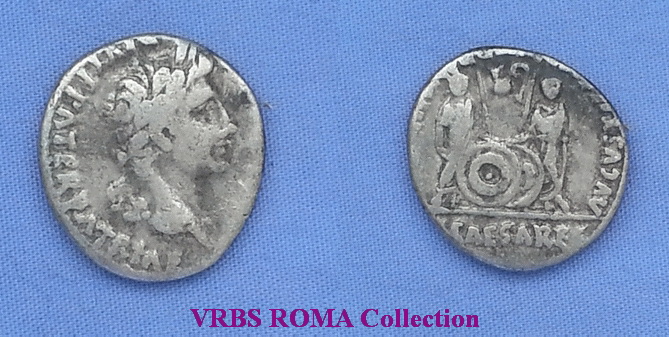
(17/18mm 3.59grms)
A1 Augustus Denarius. Lyons mint, 2 BC - ca 13 AD
CAESAR AVGVSTVS DIVI F PATER PATRIAE. laureate head
right AVGVSTI F COS DESIG PRINC IVVENT, C L CAESARES below,
Gaius & Lucius standing front, each with a hand
resting on a round shield, a spear, & in field above, a lituus right
& simpulum left
BMC 533, RSC 43
A great number of coins like this were made using silver (denarius) and
gold ( aureus). They were issued to celebrate the announcement of
Gaius and Lucius Caesars becoming heirs to the imperial throne. They
died in 4 AD and 2 AD respectively. Tiberius became the front runner
at this point. I can’t help but think about the BBC production
of ‘I Claudius’. Those two little boys running and playing as
Livia looks on. In ‘I Claudius’ Livia has these two boys killed.
She had many more killed; including Augustus himself.
There have been two thousand years of wondering what Livia’s role actually
was. A wonderful BBC production makes great fuel to add to the flames.
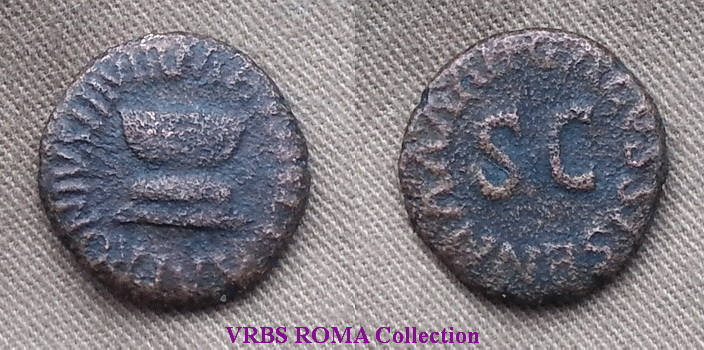
(15/16mm 2.66grms)
A2 Augustus AE Quadrans. Struck 5 BC
Moneyers Apronius, Galus, Messalla, and Sisena.
Obverse: APRONIVS MESSALLA III VIR, altar GALVS Reverse:
SISENNA A A A F F, legend around large S C
Cohen 352
The quadrans was the smallest coin in Roman Empire. It was their
penny. They are the size of a US dime, but as thick as four or five
dimes. Roman coins are thick. The sestersius, |
|
Articles
By: Anthony Ballatore
Roman Emperors & their Coins
0)
Ancient Roman Coins On Ebay
1)
When, where & why were coins first made?
2)
The Story of Romulus and Remus & The Birth of Rome
3)
The Roman Republic
4)
Julius Caesar and the Death of the Republic
5)
Augustus Caesar: The First Roman Emperor
6)
Tiberius Caesar: The First Julio-Claudian Heir
7)
Caligula: The first really crazy Caesar
8) Claudius: A level headed Caesar?
9) Nero: The Last Julio-Claudian Heir
|
|
Websites worth knowing:
WildWinds.com
By far the single best location for identifying, evaluating, and touring
ancient coins. This link will direct you to their seach engines. Enjoy.
ForumAncientCoins.com
Along with WildWinds, this is a site of the highest regard, accurate
information, and ethical policies; 'AUTHENTICITY GUARANTEED FOR ETERNITY'
says it all.
FSRCoins.com
Frank S. Robinson is a unique individual. I have more respect for Mr.
Robinson than any other coin dealer. His book 'The Case for Rational
Optimism' (2009) will most likely leave you with this same perspective.
If his book doesn't, dealing with him will. He is often mistaken for Neil
Armstrong. :-)
Harlan
J. Berk, Ltd.
Located in Chicago, Harlan J. Berk, Ltd. is an excellent location for
both common and rare coins; often of
museum quality.
Rg.ancients.info
Reid Goldsborough's web pages are well written, educational, the first
site to read regarding counterfiet coins. This site is hosted for free
by VCoins.
VCoins.com
A commercial coin and information site established December 3, 1998.
Their code of ethics and years of operation speaks loudly.
DirtyOldCoins.com
Another commercial coin and information site.
ThePenAndQuill.com
One of our sites dedicated to pens, ink, quills, books, writing, reading,
history, and anything else that envolves language, art, and ideas.
|
dupondius, and as have profiles of emperors in bas-relief.
This is my attraction to sestersii. They are huge bronze sculptures
centuries old, and they feel great ‘in hand’ as they say.
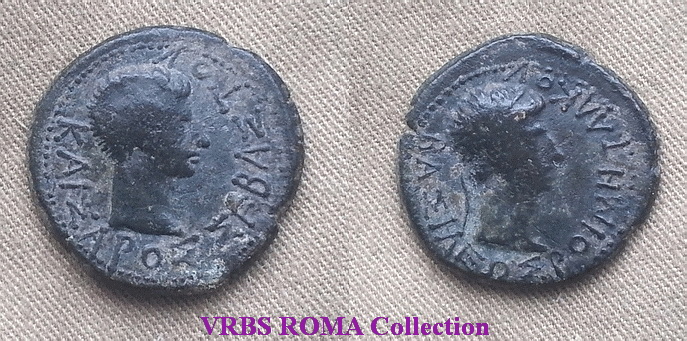
(19/20mm 4.92grms)
Augustus and Rhoemetalkes I, 11 B.C.-12 A.D. AE
Obverse: Bare bust of Augustus. Legend in Greek
Reverse: Bust of Rhoemetalkes I. Legend in Greek
This is a common provincial bronze coin with the portrait of Augustus and
Rhoemetalkes I the king of Thrace. Rhoemetalkes I was the only
non-roman to appear on a coin with Augustus. It was minted during
11 & 12 BC, and is about the size of a half dollar. I find it
interesting that both portraits resemble Augustus. This might have been
a way to draw a flattering comparison as well as show respect.
(If you have more information on Rhoemetalkes I,
II, and III, or would like to write an article on these three, please let
me know.)
A last point is about Roman coins from the Republic through the first three
centuries AD: They are stamped in bas-relief; they would not stack well.
Here is an example of three coins that I hope will bring across the high
relief of early imperial coins. As always, ancient Roman coins have
a wonderful heft in hand, and the raised sculptures are finely detailed.
The coins below are as follows:
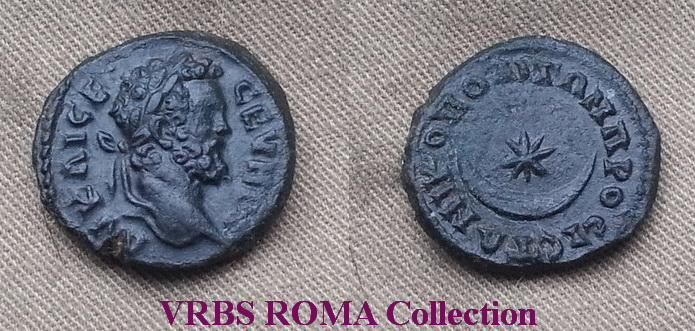
(17mm 3.8grms)
193 - 211 AD
Septimius Severus, Quadrans,
Nikopolis ad Istrum mint.
(As the name states, a quadrans was worth a quarter of an as.)
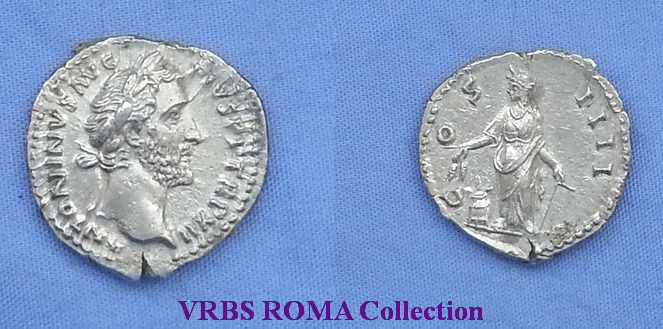
(18mm 3.03grms)
Antoninus Pius, Denarius,
AD 147-148
(Equal to 10 as)
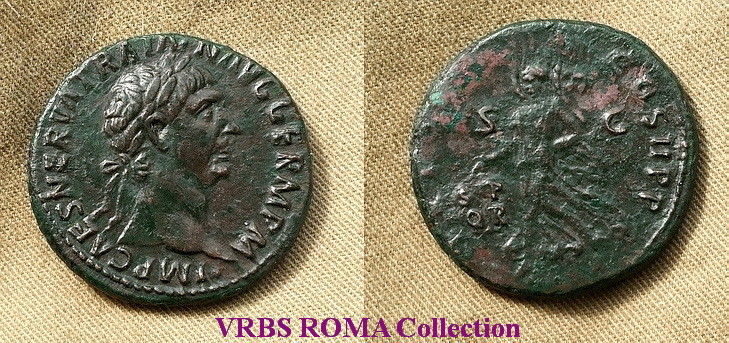
(26/27mm 9.77grms)
Trajan AE As, Rome
Struck AD 98-99
(Equal to four quadrans or one tenth of a denarius).
Coin denominations:
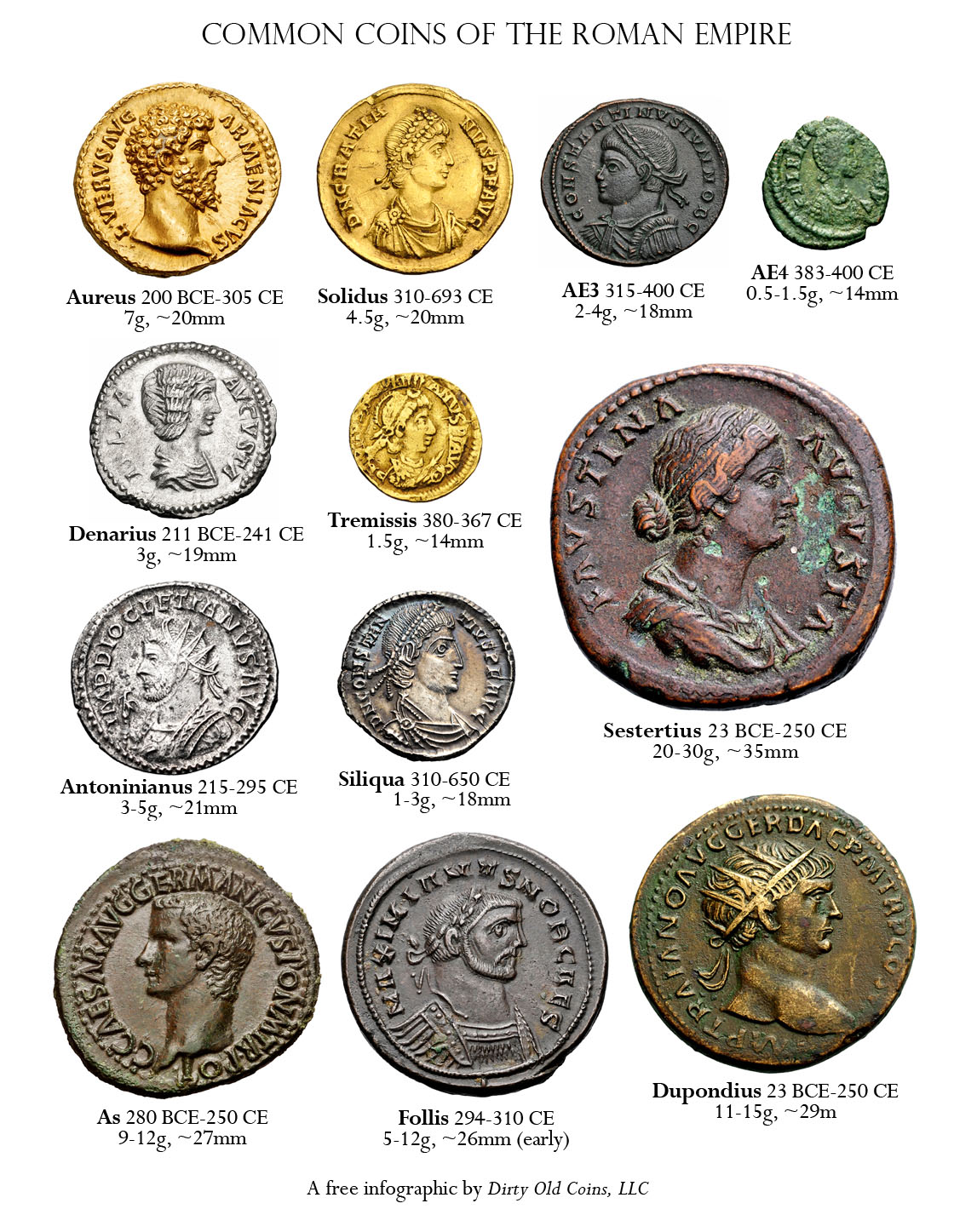
Offered to Wikipedia for Commons use by
http://dirtyoldcoins.com/
Click on this image for a larger and clearer view.
Coin exchange values at the time of minting:
A few points of curiosity regarding coin values and the cost of living
during the 1st century:
-
1) Two (as) would get you a loaf of bread.
-
2) A donkey might cost 100 to 125 denarii.
-
3) A half liter of wine would cost 5 to 10 as depending
on its quality.
-
4) A slave would be from 500 to 1,500 denarii; up to 5,000
denarii for a female slave.
5) Wages were something like this: A clerk,
secretary, or laborer would earn from 10 to 20 denarii a month. A
legionary soldier would earn about 18 to 20 denarii a month, but the soldier
was occassionally offered the opportunity to loot & receive large bonuses
and rewards.
|
|
|